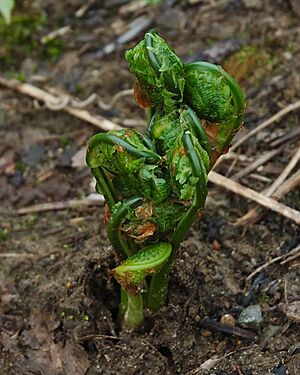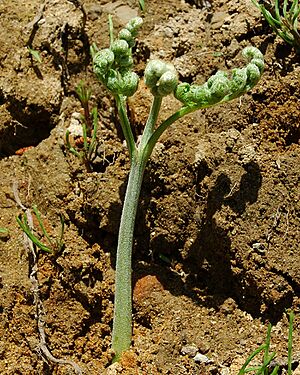Sansai facts for kids
Sansai (山菜) is a Japanese word that means "mountain vegetables." These are plants that grow naturally in the wild, often found in mountains or forests. People used to gather them from nature, rather than growing them on farms.
Today, some sansai are also grown on farms. For example, certain fern shoots like bracken (called warabi) and zenmai are now farmed. This helps make sure there's enough for everyone to enjoy.
You can often find sansai already cooked and packed in water. They might be in plastic bags or containers. Common types sold include warabi (bracken fern shoots) and fuki (butterbur stalks). Sometimes, you can find mixes with baby bamboo shoots and mushrooms too. These are available in many supermarkets.
Sansai are also an important part of shōjin ryōri. This is a special type of vegetarian cooking often eaten in Buddhist temples.
What Are Some Sansai?
Many different plants are considered sansai. Here are some examples:
- Bamboo Shoots: Chishimazasa (チシマザサ) or Nemagaridake are young shoots from a type of bamboo.
- Butterbur: Fuki-no-tō (Petasites japonicus) are the flower shoots of the butterbur plant.
- Wild Garlic: Gyojaninniku (Allium ochotense) is a wild plant similar to ramps.
- Young Leaves:
- Hana-ikada (ハナイカダ) from the Helwingia japonica plant.
- Harigiri (Kalopanax) leaves, which are a bit tart.
- Koshiabura (コシアブラ) from the Chengiopanax sciadophylloides tree.
- Mitsuba (ミツバ), also known as Japanese parsley.
- Nomijigasa (モミジガサ), a plant from the aster family.
- Nirinsō (ニリンソウ) from Anemone flaccida. Be careful, as it can look like a poisonous plant called wolfsbane.
- Nogeshi (Sonchus oleraceus), also known as sowthistle.
- Shiode (Smilax riparia var. ussuriensis).
- Uwabamisō (Elatostema umbellatum var. majus).
- Nettle-like Plants: Niyama-irakusa (ミヤマイラクサ) are similar to nettles. Their young leaves and stems are eaten, but they have stinging hairs, so you need to be careful when handling them.
- Wild Onions: Nobiru (ノビル) from Allium macrostemon are like wild field garlic.
- Japanese Parsley: Seri from Oenanthe javanica.
- Kiwi-like Fruits: Sarunashi (Actinidia arguta) produces small fruits that can be eaten fresh or used to flavor drinks.
- Angelica Tree Shoots: Tara no me from the Japanese angelica tree (Aralia elata) are young shoots.
- Water Pepper: Tade (Persicaria hydropiper) leaves and shoots are used in sauces or as a garnish.
- Leopard Plant: Tsuwabuki (Farfugium japonicum) stems are prepared in a similar way to fuki.
- Japanese Spikenard: Udo (Aralia cordata) is another popular sansai.
- Fern Shoots:
- Kogomi from Matteuccia struthiopteris.
- Warabi from Pteridium aquilinum (bracken).
- Zenmai is another type of fern top. It is often considered more special than kogomi or warabi and is also sold dried.
See also
 In Spanish: Sansai para niños
In Spanish: Sansai para niños



